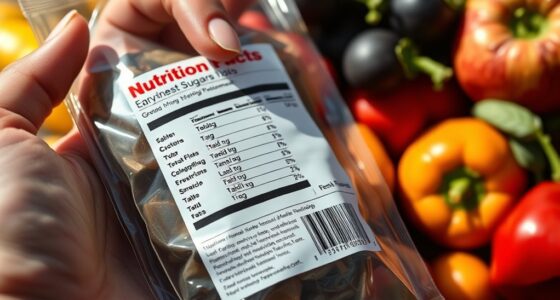To manage GERD, focus on consuming gentle, low-acid foods like oatmeal, bananas, leafy greens, and lean proteins such as chicken and fish. Avoid spicy, fried, citrus, and tomato-based dishes, as well as carbonated drinks and caffeine, which can trigger symptoms. Drinking water helps dilute acid, while ginger and herbal teas soothe digestion. Staying mindful of your choices can make a big difference—keep exploring to discover more tips for a comfortable, reflux-friendly diet.
Key Takeaways
- Consume low-acid, gentle foods like oatmeal, bananas, leafy greens, and lean proteins to reduce GERD symptoms.
- Incorporate ginger and non-citrus herbs to soothe digestion without triggering reflux.
- Limit or avoid spicy, fried, citrus, tomato-based, and processed foods that can worsen GERD.
- Opt for whole grains, legumes, and herbal teas to promote digestive health and reduce acid reflux.
- Stay hydrated with water and avoid carbonated drinks, caffeine, and alcohol to prevent esophageal relaxation.
Foods That Help Ease GERD Symptoms

Certain foods can help soothe GERD symptoms and reduce discomfort. Incorporating these into your diet may provide relief during flare-ups. Oatmeal is an excellent choice because it’s high in fiber and gentle on your stomach. Lean proteins like chicken, turkey, and fish are less likely to trigger acid reflux. Ginger has natural anti-inflammatory properties that can calm your digestive system, making it a good addition. Non-citrus herbs, such as basil or oregano, add flavor without increasing acidity. Drinking plenty of water helps dilute stomach acid and flush out irritants. Remember to eat smaller, more frequent meals instead of large ones, which can put extra pressure on your stomach. For added support, understanding ketogenic dietary approaches can offer insights into managing inflammation and promoting gut health. These dietary choices can make managing GERD more comfortable and effective.
Fruits and Vegetables Suitable for a GERD-Friendly Diet
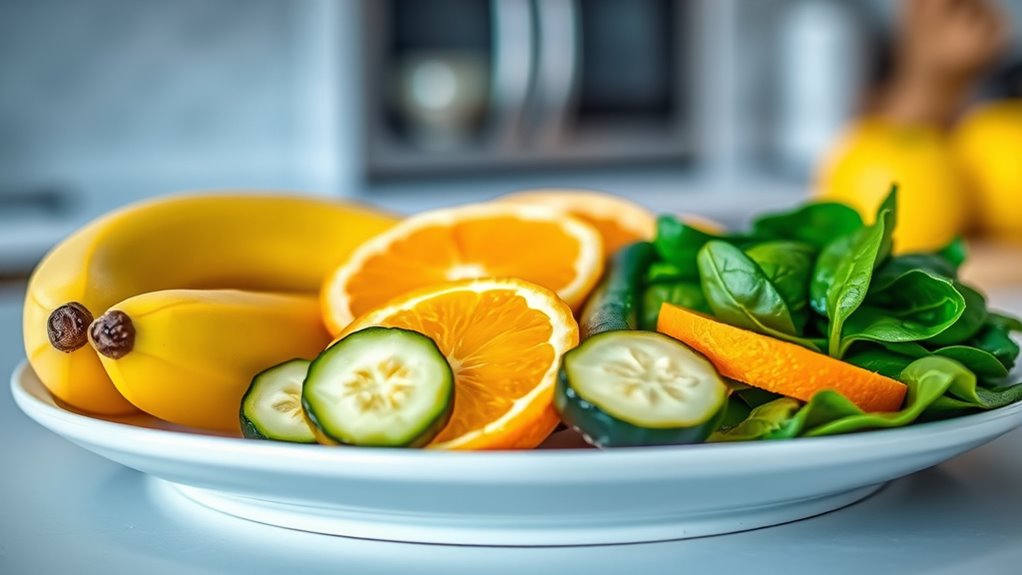
When choosing fruits and vegetables for your GERD-friendly diet, focus on gentle, low-acid options. These foods are less likely to trigger symptoms and can help keep your stomach calm. Opting for the right produce makes a significant difference in managing your condition. For example, selecting fresh produce over canned options can reduce acidity and preserve nutrient quality.
Gentle Fruits and Vegetables
If you’re managing GERD, choosing gentle fruits and vegetables can help reduce symptoms and promote comfort. Opt for fruits like bananas, melons, and apples, which are less acidic and easier on your stomach. These gentle options provide essential nutrients without irritating your esophagus. When selecting vegetables, go for leafy greens, carrots, zucchini, and green beans, as they’re mild and unlikely to cause reflux. Avoid spicy or highly processed vegetables, which can trigger symptoms. Incorporating these gentle fruits and vegetables into your meals can help you enjoy a variety of flavors while minimizing discomfort. Remember, eating slowly and in moderation also aids digestion, making it easier to manage GERD symptoms effectively. Herbal teas may also soothe digestive discomfort and reduce inflammation, supporting your GERD-friendly diet.
Low-Acid Produce Options
Focusing on low-acid produce options can make a noticeable difference in managing GERD symptoms. These fruits and vegetables are gentle on your stomach and less likely to trigger reflux. Consider incorporating:
- Bananas – creamy and naturally sweet, they coat your stomach lining.
- Melons – juicy and revitalizing, they have a mild acidity that won’t irritate.
- Leafy greens – spinach and lettuce are light, nutrient-packed, and gentle on digestion.
– Using automated cleaning features can help maintain hygiene in your kitchen while preparing these gentle foods.
Choosing these options helps keep your reflux under control while still enjoying flavorful, nutritious foods. Remember, moderation is key, and it’s best to prepare these produce items in a way that avoids added acids or spices. By focusing on these low-acid choices, you support your digestive health and reduce discomfort.
Whole Grains and Legumes That Support Digestive Health

Whole grains and legumes are excellent choices for supporting digestive health, especially when managing GERD. They provide fiber, which helps regulate digestion and keeps things moving smoothly. When selecting grains, opt for oatmeal, brown rice, barley, or whole wheat products, as they are gentle on your stomach and less likely to trigger reflux. Legumes like lentils, chickpeas, and beans are nutritious options, but introduce them gradually to avoid gas and bloating. Cooking them thoroughly improves digestibility. These foods can help absorb stomach acid and promote regularity, reducing GERD symptoms. Incorporating chlorophyll-rich foods into your diet can also support detoxification and overall gut health. Be mindful of portion sizes to prevent discomfort. Incorporating these whole grains and legumes into your diet can strengthen your digestive system and support overall gut health, making reflux more manageable.
Lean Proteins and Dairy Options for GERD Sufferers
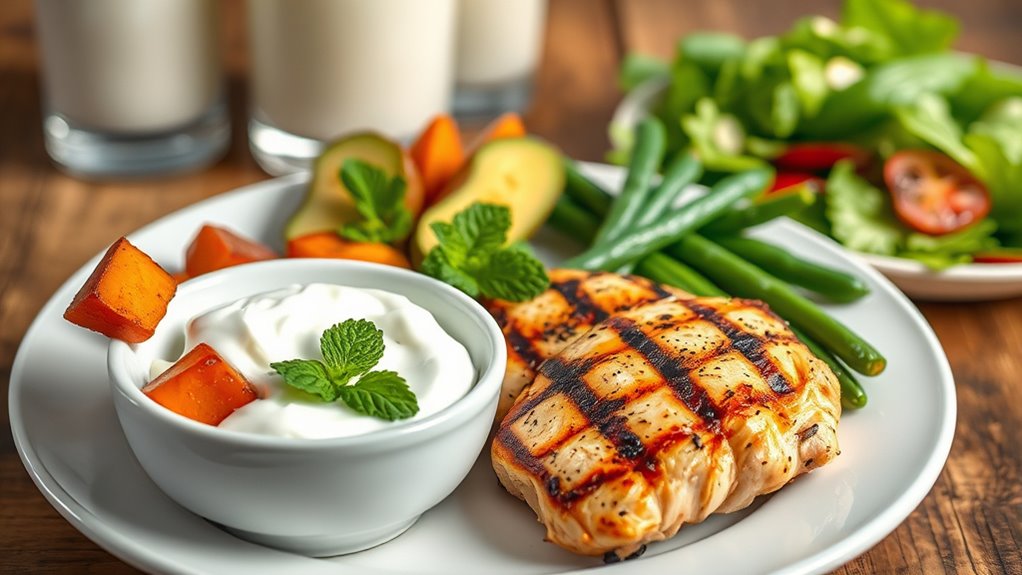
Are you looking for protein options that won’t aggravate your GERD? Focus on lean proteins and gentle dairy choices. These foods can help you meet your nutritional needs without triggering symptoms. Imagine:
- Skinless chicken breast, grilled to perfection, offering a tender, low-fat option.
- White fish like cod or tilapia, baked with herbs, providing a mild, soothing flavor.
- Low-fat or lactose-free dairy, such as yogurt or milk, which can be easier to digest and less likely to cause discomfort.
- Selecting mild-flavored foods supports digestion and minimizes reflux episodes, making your diet more comfortable.
Choosing these options keeps your digestion calm while maintaining essential protein intake. Avoid fried or heavily processed meats, and select dairy products with reduced fat content. Sticking to these foods helps manage GERD symptoms effectively.
Common Foods and Beverages to Limit or Avoid
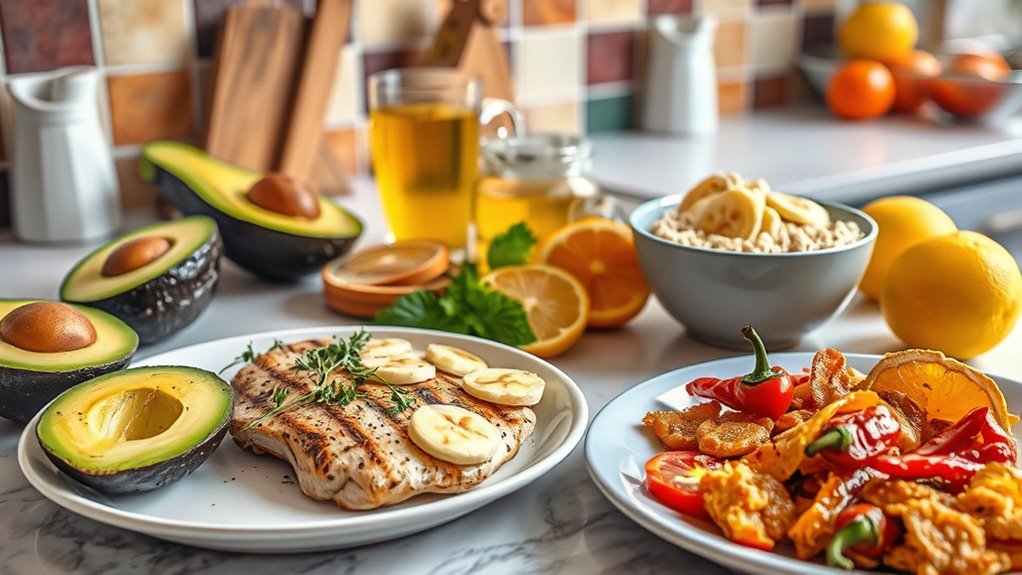
Certain foods and beverages can trigger or worsen GERD symptoms, so it’s important to limit or avoid them. Spicy foods, like hot peppers and curry, can irritate your esophagus and cause heartburn. Fried and greasy foods slow digestion and increase acid reflux. Citrus fruits such as oranges and lemons are highly acidic, leading to discomfort. Tomatoes and tomato-based products, including sauces and ketchup, are common culprits. Carbonated drinks introduce gas that can cause bloating and pressure on the stomach. Caffeinated beverages like coffee and tea relax the lower esophageal sphincter, making reflux more likely. Alcohol, especially in excess, also relaxes this muscle and irritates the esophagus. Additionally, Dog names can sometimes be a fun way to personalize your health journey and stay motivated. By reducing these foods and drinks, you can better manage your GERD symptoms and avoid unnecessary discomfort.
Tips for Creating a Balanced, GERD-Healthy Meal Plan
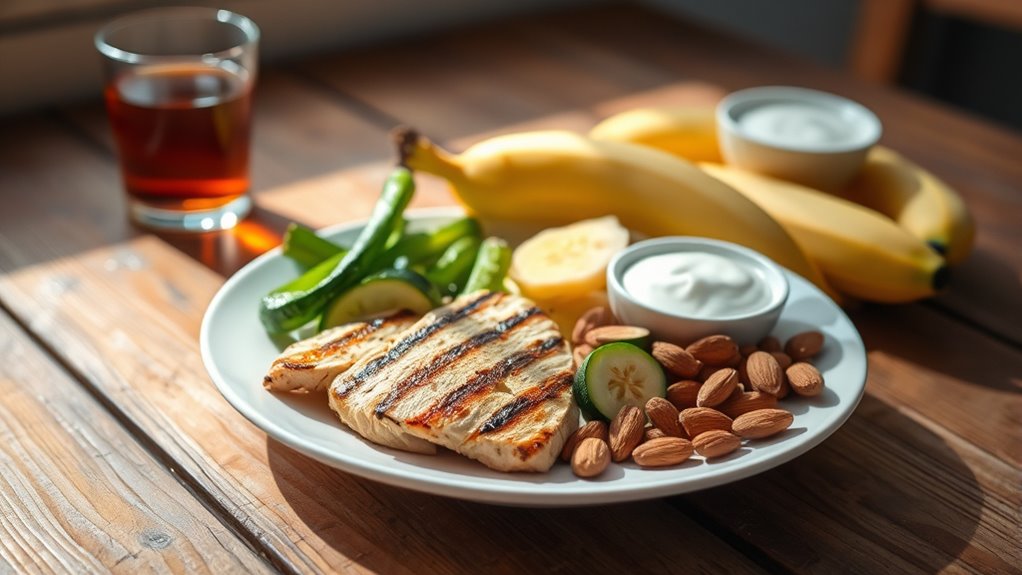
Creating a balanced, GERD-friendly meal plan involves choosing foods that soothe your digestive system while providing essential nutrients. Focus on incorporating gentle, non-acidic options that won’t trigger symptoms. To build a meal plan, consider these tips:
- Visualize your plate divided into sections: one with lean proteins like chicken or fish, another with whole grains such as brown rice, and a portion with non-acidic vegetables like zucchini or green beans.
- Incorporate healthy fats from sources like avocados or olive oil to support digestion without aggravating GERD.
- Plan smaller, more frequent meals instead of large ones to reduce stomach pressure and prevent reflux. This approach keeps your digestion steady and symptoms manageable.
- Regularly assess and rotate your food choices to prevent dietary monotony and ensure a variety of nutrients, aligning with home improvement principles of organization and adaptability.
Frequently Asked Questions
Can I Consume Spicy Foods While Managing GERD Symptoms?
Spicy foods can trigger GERD symptoms for many people, so you might want to limit or avoid them to reduce discomfort. If you’re unsure, try eating small amounts and monitor how your body reacts. Sometimes, spices cause irritation and increase acid reflux. Ultimately, listening to your body helps you identify personal triggers, and you should consult your healthcare provider for tailored advice on managing your GERD effectively.
Are There Any Specific Cooking Methods Recommended for Gerd-Friendly Meals?
You might find it interesting that gentle cooking methods can actually help manage your GERD symptoms. Baking, steaming, grilling, and boiling are excellent options because they don’t add extra fats or spices that could trigger discomfort. When you prepare meals this way, you’re not only preserving flavors but also reducing reflux risks. So, choose these methods for a soothing, GERD-friendly meal that keeps your stomach happy and healthy.
How Can I Identify Personal Trigger Foods for GERD?
To identify your personal trigger foods for GERD, keep a detailed food diary, noting everything you eat and how you feel afterward. Pay attention to symptoms like heartburn or indigestion. Over time, you’ll notice patterns and can pinpoint specific foods that worsen your symptoms. Avoid those triggers and experiment gradually with new foods, always observing how your body reacts to find what works best for you.
Is It Safe to Drink Herbal Teas With GERD?
Think of your stomach as a delicate garden; herbal teas can be like gentle rain, but some may be too harsh. Generally, herbal teas like chamomile or ginger are safe and can soothe symptoms. However, peppermint tea might trigger reflux for some. Always start with small sips and observe how your body reacts. If any tea worsens your symptoms, it’s best to avoid it and consult your doctor.
What Are Some Healthy Snack Options for GERD Sufferers?
When choosing snacks for GERD, you want options that soothe your stomach and avoid trigger ingredients. Opt for low-fat, non-acidic choices like bananas, applesauce, or plain crackers. You can also try Greek yogurt or a handful of almonds, but avoid spicy or greasy snacks. Always listen to your body, and if a snack causes discomfort, cut back or try something different to keep your symptoms in check.
Conclusion
By choosing gentle, nourishing foods and being mindful of your choices, you can create a meal routine that supports comfort and peace. Embrace the small changes, knowing they brighten your days and ease your nights. Remember, each mindful bite is a step toward feeling lighter and more at ease. With patience and care, you can find a rhythm that brings harmony to your digestion and joy to your table.





